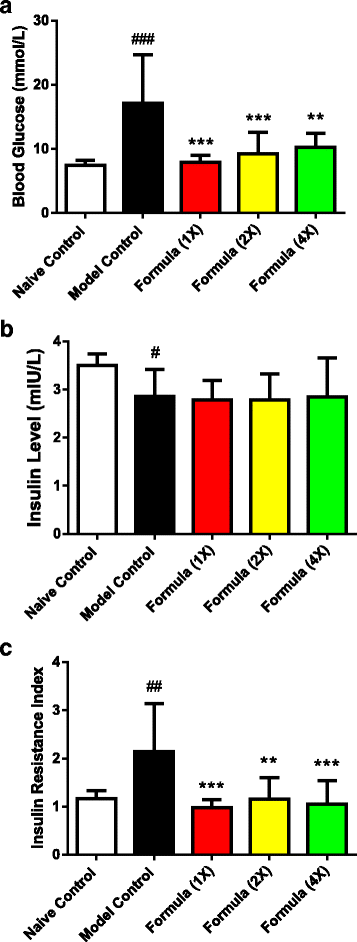A novel botanical formula prevents diabetes by improving insulin resistance
- PMID: 28679380
- PMCID: PMC5499036
- DOI: 10.1186/s12906-017-1848-3
A novel botanical formula prevents diabetes by improving insulin resistance
Abstract
Background: Type 2 diabetes mellitus (T2DM) is a major risk factor for cardiovascular disease, and the prevalence has increased significantly in recent decades to epidemic proportions in China. Individually, fenugreek (Trigonella foenum graecum) seed, mulberry (Morus alba L.) leaf and American ginseng (Panax quinquefolius) root can improve glycemia in various animal models and humans with impaired glucose metabolism and T2DM. The aim of this study was to design an optimized botanical formula containing these herbal extracts as a nutritional strategy for the prevention of insulin resistance and T2DM.
Methods: Cell-free α-amylase and α-glucosidase enzyme assays were used to determine inhibitory potential of extracts. Glucose uptake was examined in differentiated human adipocytes using radiolabeled 2-deoxyglucose. Male Sprague Dawley rats were divided and glycemia balanced into 5 groups: two controls (naïve and model) and three doses of the botanical test formula containing standardized fenugreek seed, mulberry leaf and American ginseng extracts (42.33, 84.66 and 169.33 mg/kg BW). Insulin resistance and T2DM was induced by feeding animals a high fat diet and with an alloxan injection. Glucose tolerance was examined by measuring serum glucose levels following an oral glucose load.
Results: Fenugreek seed and mulberry leaf dose dependently inhibited α-amylase (IC50 = 73.2 μg/mL) and α-glucosidase (IC50 = 111.8 ng/mL), respectively. All three botanical extracts improved insulin sensitivity and glucose uptake in human adipocytes, which lead to the design of an optimized botanical test formula. In a rat model of insulin resistance and T2DM, the optimized botanical test formula improved fasting serum glucose levels, fasting insulin resistance and the development of impaired glucose tolerance. The reduction in epididymal adipose tissue GLUT4 and PDK1 expression induced by high fat diet and alloxan was blunted by the botanical test formula.
Conclusions: A novel botanical formula containing standardized extracts of mulberry leaf, fenugreek seed and American ginseng at a ratio of 1:1.3:3.4 prevented the development of insulin resistance, impaired glucose tolerance and T2DM. Given the rising need for effective non-drug targeting of insulin resistance and progression to T2DM, complementary and alternative nutritional strategies without intolerable side effects could have meaningful impact on metabolic health and diabetes risks.
Keywords: Alloxan; American ginseng; Botanical test formula; Fenugreek seed; GLUT4; High fat diet; Insulin resistance; Mulberry leaf; Type 2 diabetes mellitus.
Conflict of interest statement
Ethics approval
All animal experiments were approved by the Institutional Animal Care and Use Committee of Beijing Institute for Drug Control.
Competing interests
All the authors are employees of the Nutrilite Health Institute.
Publisher’s Note
Springer Nature remains neutral with regard to jurisdictional claims in published maps and institutional affiliations.
Figures






References
-
- Association AD: 2. Classification and diagnosis of diabetes. Diabetes Care 2015, 38(Supplement 1):S8-S16. - PubMed
MeSH terms
Substances
LinkOut - more resources
Full Text Sources
Other Literature Sources
Medical
Miscellaneous

